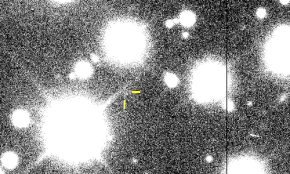Erinome
 Erinome imaged by the Canada-France-Hawaii Telescope in December 2001 | |
| Discovery[1] | |
|---|---|
| Discovered by | Scott S. Sheppard David C. Jewitt Yanga R. Fernandez Eugene A. Magnier |
| Discovery site | Mauna Kea Observatory |
| Discovery date | 23 November 2000 |
| Designations | |
Designation | Jupiter XXV |
Named after | Erinoma (Greek form unknown)[a] |
| S/2000 J 4 | |
| Orbital characteristics[2] | |
| Epoch 17 December 2020 (JD 2459200.5) | |
| Observation arc | 16.34 yr (5,967 days) |
| 0.1494286 | |
| Eccentricity | 0.2052559 |
| –682.80 d | |
| 98.99686° | |
| 0° 31m 38.062s / day | |
| Inclination | 164.81976° (to ecliptic) |
| 34.02660° | |
| 81.11760° | |
| Satellite of | Jupiter |
| Group | Carme group |
| Physical characteristics[3] | |
| 3 km | |
| Albedo | 0.04 (assumed) |
Spectral type | B–V = 0.72 ± 0.06, V–R = 0.42 ± 0.04[4] |
| 22.8[5] | |
| 16.0[2] | |
Erinome, also known as Jupiter XXV, is a retrograde irregular satellite of Jupiter. It was discovered by a team of astronomers from the University of Hawaii led by Scott S. Sheppard in 2000, and given the temporary designation S/2000 J 4.[6][1]
Erinome is about 3 kilometres in diameter, and orbits Jupiter at an average distance of 22,986,000 km in 682.80 days, at an inclination of 164° to the ecliptic (162° to Jupiter's equator), in a retrograde direction and with an eccentricity of 0.2552.
It belongs to the Carme group, made up of irregular retrograde moons orbiting Jupiter at a distance ranging between 23 and 24 Gm and at an inclination of about 165°.
Name
[edit]Erinome was named in October 2002 after the mythological Erinoma, a Cypriot woman said by the discovery group to be a "daughter of Celes, compelled by Venus to fall in love with Jupiter."[7] In the surviving myths however, it is actually Jupiter (Zeus) whom Venus (Aphrodite) makes fall in love with Erinoma, in order to ruin her.[a]
The final -a vowel of the name was changed to -e to accord with I
Notes
[edit]References
[edit]- ^ a b MPEC 2001-A28: S/2000 J 2, S/2000 J 3, S/2000 J 4, S/2000 J 5, S/2000 J 6 2001 January 5 (discovery and ephemeris)
- ^ a b "M.P.C. 127088" (PDF). Minor Planet Circular. Minor Planet Center. 17 November 2020.
- ^ "Planetary Satellite Physical Parameters". Jet Propulsion Laboratory. 19 February 2015. Retrieved 27 November 2020.
- ^ Graykowski, Ariel; Jewitt, David (5 April 2018). "Colors and Shapes of the Irregular Planetary Satellites". The Astronomical Journal. 155 (4): 184. arXiv:1803.01907. doi:10.3847/1538-3881/aab49b. ISSN 1538-3881.
- ^ Sheppard, Scott. "Scott S. Sheppard - Jupiter Moons". Department of Terrestrial Magnetism. Carnegie Institution for Science. Retrieved 27 November 2020.
- ^ IAUC 7555: Satellites of Jupiter Archived 2002-09-16 at the Wayback Machine 2001 January 5 (discovery)
- ^ a b USGS Gazetteer of Planetary Nomenclature
